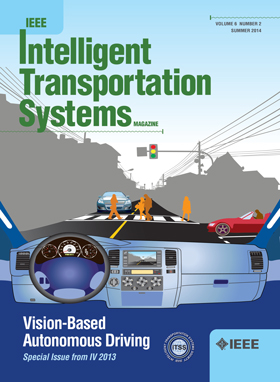ICST-DNET: An Interpretable Causal Spatio-Temporal Diffusion Network for Traffic Speed Prediction
IF 7.9
1区 工程技术
Q1 ENGINEERING, CIVIL
IEEE Transactions on Intelligent Transportation Systems
Pub Date : 2025-06-12
DOI:10.1109/TITS.2025.3574837
引用次数: 0
Abstract
Traffic speed prediction is significant for intelligent navigation and congestion alleviation. However, making accurate predictions is challenging due to three factors: 1) traffic diffusion, i.e., the spatial and temporal causality existing between the traffic conditions of multiple neighboring roads, 2) the poor interpretability of traffic data with complicated spatio-temporal correlations, and 3) the latent pattern of traffic speed fluctuations over time, such as morning and evening rush. Jointly considering these factors, in this paper, we present a novel architecture for traffic speed prediction, called Interpretable Causal Spatio-Temporal Diffusion Network (ICST-DNET). Specifically, ICST-DNET consists of three parts, namely the Spatio-Temporal Causality Learning (STCL), Causal Graph Generation (CGG), and Speed Fluctuation Pattern Recognition (SFPR) modules. First, to model the traffic diffusion within road networks, an STCL module is proposed to capture both the temporal causality on each individual road and the spatial causality in each road pair. The CGG module is then developed based on STCL to enhance the interpretability of the traffic diffusion procedure from the temporal and spatial perspectives. Specifically, a time causality matrix is generated to explain the temporal causality between each road’s historical and future traffic conditions. For spatial causality, we utilize causal graphs to visualize the diffusion process in road pairs. Finally, to adapt to traffic speed fluctuations in different scenarios, we design a personalized SFPR module to select the historical timesteps with strong influences for learning the pattern of traffic speed fluctuations. Extensive experimental results on two real-world traffic datasets prove that ICST-DNET can outperform all existing baselines, as evidenced by the higher prediction accuracy, ability to explain causality, and adaptability to different scenarios.交通速度预测的可解释因果时空扩散网络
交通速度预测对于智能导航和缓解拥堵具有重要意义。然而,由于交通扩散,即多个相邻道路的交通状况之间存在时空因果关系,交通数据的可解释性较差,时空相关性复杂,交通速度随时间波动的潜在模式,如早高峰和晚高峰,因此要做出准确的预测是一项挑战。综合考虑这些因素,本文提出了一种新的交通速度预测架构,称为可解释因果时空扩散网络(ICST-DNET)。具体来说,ICST-DNET由三个部分组成,即时空因果关系学习(STCL)、因果图生成(CGG)和速度波动模式识别(SFPR)模块。首先,为了模拟道路网络内的交通扩散,提出了一个STCL模块来捕获每条道路上的时间因果关系和每条道路对的空间因果关系。然后,基于STCL开发了CGG模块,从时间和空间的角度增强了交通扩散过程的可解释性。具体来说,生成时间因果矩阵来解释每条道路的历史和未来交通状况之间的时间因果关系。对于空间因果关系,我们利用因果图来可视化道路对中的扩散过程。最后,为了适应不同场景下的交通速度波动,我们设计了个性化的SFPR模块,选择影响较大的历史时间步长进行交通速度波动模式的学习。在两个真实交通数据集上的大量实验结果证明,ICST-DNET可以优于所有现有的基线,这证明了其更高的预测精度、解释因果关系的能力以及对不同场景的适应性。
本文章由计算机程序翻译,如有差异,请以英文原文为准。
求助全文
约1分钟内获得全文
求助全文
来源期刊

IEEE Transactions on Intelligent Transportation Systems
工程技术-工程:电子与电气
CiteScore
14.80
自引率
12.90%
发文量
1872
审稿时长
7.5 months
期刊介绍:
The theoretical, experimental and operational aspects of electrical and electronics engineering and information technologies as applied to Intelligent Transportation Systems (ITS). Intelligent Transportation Systems are defined as those systems utilizing synergistic technologies and systems engineering concepts to develop and improve transportation systems of all kinds. The scope of this interdisciplinary activity includes the promotion, consolidation and coordination of ITS technical activities among IEEE entities, and providing a focus for cooperative activities, both internally and externally.
 求助内容:
求助内容: 应助结果提醒方式:
应助结果提醒方式:


